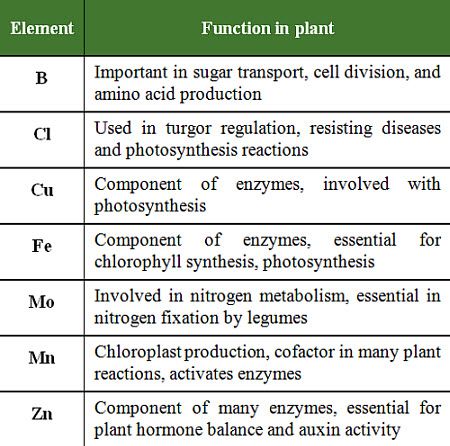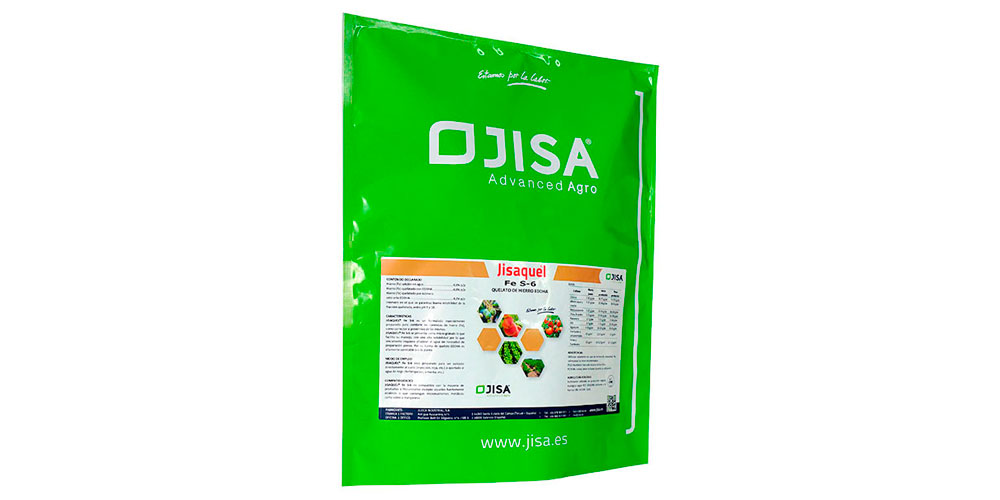Microelements for plants

In the fertilization of crops, the expressions of microelements, micronutrients or trace elements, allude to the same thing: nutritional elements for the plant that, being essential for its good development, are absorbed by them during their cultivation, in relatively low or very high quantities. low.
Micronutrients of a metallic nature
In the soil and prepared substrates, microelements are present, considered metallic in nature, such as, for example, Iron (Fe), Manganese (Mn), Copper (Cu) and Zinc (Zn), mainly as oxides or hydroxides or other salts quite insoluble at basic or alkaline pH.
On the other hand, there are other microelements, such as Boron (B) and Molybdenum (Mo), which are necessary for the proper development of plants in even smaller quantities. These in particular are more soluble and their presence depends on the content in the irrigation water or other materials provided, such as organic matter.
In addition, there is also Chlorine (Cl) as a trace element, which, although it is required in low concentrations by the plant, is generally found in more than sufficient quantity, either in the irrigation water or in the fertilizers that are commonly used.
Another topic is the substrates for hydroponics, such as perlite, vermiculite, rock wool, coconut fiber, sand, picón, etc. These substrates, called inert, do not contain the minimum amounts of trace elements necessary for plants, so their contribution must be taken into account in the fertilization plans.
Amount of micronutrients or trace elements
As for the range of quantities of micronutrients or trace elements that a plant needs, in general terms, it is very narrow for its correct development.
This range must be monitored, since its amount, both by default and by excess, a certain microelement, can go from being a deficiency to a phytotoxicity very easily.
microelements or macroelements
As in many other aspects of life, things never have to be always like this. And that also happens in the world of trace elements for plants.
Although initially the group of microelements included elements such as Iron (Fe), Sulfur (S), Manganese (Mn), Calcium (Ca), Magnesium (Mg), Copper (Cu), Zinc (Zn), Boron (B), Molybdenum (Mo) and Chlorine (Cl), … Currently, there are authors and researchers who extract some elements from this group to associate them with the macronutrients.
These are Calcium (Ca), Magnesium (Mg) and Sulfur (S), which, although, do not introduce them at the same level as NPK. These trace elements are considered to be needed by plants in relatively larger volumes than those of the group of microelements mentioned above.
deficiency correctors
More than phytotoxicities due to excess microelements, the most common is that deficiencies of one or several trace elements occur in crops, compromising the profitability of the crops. In the case of ornamentals too, since it is commercially devalued.
For this, there are companies that manufacture deficiency correctors, formulating specific products for a single trace element, several or all of them.
They are products developed to be applied, according to their formulation, in irrigation or by foliar route. And they are incorporated into subscriber plans to ensure or correct their deficiencies in certain phases of plant development.

As an example, one of the most popular is the iron chelate, one of the most effective iron deficiency correctors being the EDDHA iron chelate, also known as Fe-EDDHA chelated iron.

![Photo of Plant Gardenias: [Care, Planting, Irrigation, Substrate]](https://www.complete-gardening.com/wp-content/uploads/2022/08/plant-gardenias-care-planting-irrigation-substrate-390x220.jpg)

![Photo of Transplant Rosemary: [Steps to follow and Data to take into account]](https://www.complete-gardening.com/wp-content/uploads/2022/08/transplant-rosemary-steps-to-follow-and-data-to-take-into-account-390x220.jpg)
